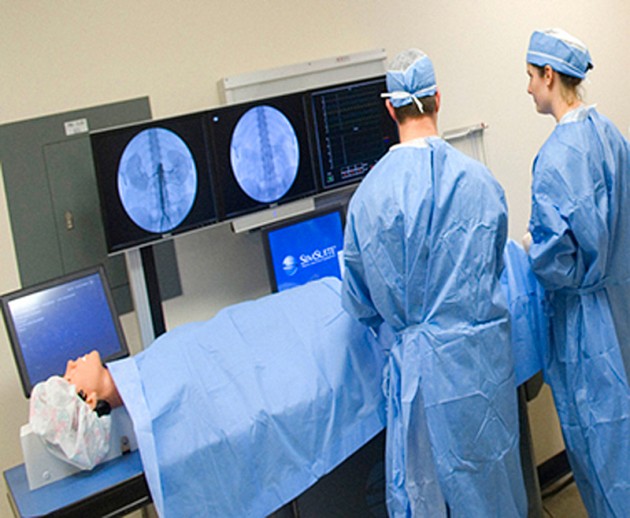Simulator to give extra medical experience

A realistic dummy dressed in a hospital gown might be USF medical students’ newest patient.
That’s because USF Health has a new partnership with Medical Simulation Corporation that gives students hands-on experience before they enter the medical field.
USF Health is completing work on a simulation suite — a series of rooms in which medical situations are imitated — at teaching affiliate Tampa General Hospital (TGH). The idea for a simulation center came about when Dr. Murray Shames began searching for a way to teach his residents endovascular procedures, said Dr. Deborah Sutherland, associate vice president and associate dean at USF Health.
“There’s going to be six simulation labs and a conference area and it is meant for physicians, fellows, residents, nursing and allied health care people. It’s a training center based on simulation,” said Stephanie McKown, SimSuite Clinical Education Specialist.
Two of the six dummies, or simulators, will be Medical Simulation Corporation’s SimSuite Simulators. These simulators will provide training in cardiovascular and endovascular procedures, as well as critical care cases.
“The simulation center at Tampa General Hospital is broader than just the partnership with medical simulation. That center will have a variety of high-fidelity surgical and interventional simulators,” Sutherland said.
The pale-skinned bodies of the dummies have lifelike faces and hair. Each simulator is in a different room, set on an operation table, with tools and monitors like those of a real surgery room. The dummies even speak to the medical students during the simulation, saying phrases such as, “I’m having a terrible chest pain, doc.”
“We have developed it so when you’re doing endovascular procedures, all the catheters that you stick into the simulator feel very similar to what the medical professional would feel if they were doing an actual procedure,” said Debbie Fimple, health care product manager with Medical Simulation Corporation. “The human patient simulator that we work with for our critical care courses is even more lifelike. That simulator has real breath sounds and lung sounds.”
The center is set to be ready for student use Jan. 8, 2009, Sutherland said. USF’s contract with the corporation is expected to cost $380,000 per year over three years. The Office of Continuing Professional Development, the College of Nursing, and both the undergraduate and graduate medical programs plan to split the cost.
Medical students interested in training at the USF TGH simulation center must get approval from the USF Health Office of Continuing Professional Development, McKown said.
“Those students who are doing their medical student rotations at Tampa General will have access to train on the simulators. That will be for introductory skill activities,” Sutherland said.
“Students who may be aspiring to be cardiologists or vascular surgeons could go in and we have some didactic, web-based courseware they could take a look at to familiarize themselves with concepts,” Fimple said.
Students could then practice the skills they have read about by working on a simulation case at the USF TGH center.
“With a simulator they can practice these skills and scenarios as many times as they need to become proficient before they go into the clinical area,” Sutherland said.
According to the Medical Simulation Corporation’s Web site, USF is the only university in the state with such a program.
“When any of us go to the hospital we expect that the person knows what they are doing. Nobody wants to be first, when somebody says ‘Oh, this is my first time — I just read the manual last night.’ (The simulator) gives them that first experience,” McKown said.
Taylor Caragan, a freshman majoring in nursing, likes the idea of a simulation center.
“I think that they are great devices for training, especially for diagnosing certain problems that are not initially easy to spot,” she said. “I can’t wait to use them some day.”





